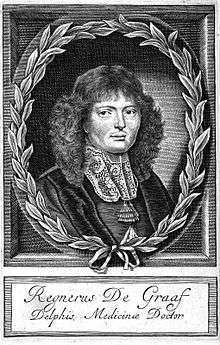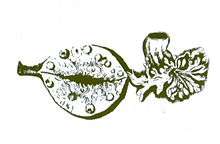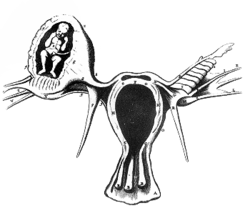Regnier de Graaf
Regnier de Graaf (English spelling), original Dutch spelling Reinier de Graaf, or Latinized Reijnerus de Graeff (30 July 1641 – 17 August 1673) was a Dutch physician and anatomist who made key discoveries in reproductive biology. His first name is often spelled Reinier or Reynier.
Regnier de Graaf | |
|---|---|
 Regnier de Graaf | |
| Born | 30 July 1641 |
| Died | 17 August 1673 (aged 32) |
| Nationality | Dutch |
| Known for | reproductive biology syringe ovarian follicle |
| Scientific career | |
| Fields | anatomist |
| Influences | Franciscus Sylvius |
Biography
De Graaf was born in Schoonhoven and perhaps a relative to the De Graeff regent family.[1] He studied medicine in Utrecht and Leiden. There his co-students were Jan Swammerdam, Niels Stensen and Frederik Ruysch, one of their professors was Franciscus Sylvius. (All of them were interested in the organs of procreation.) He submitted his doctoral thesis on the pancreas, and went to France where he obtained his medical degree from the University of Angers. While in Paris, he also turned to the study of the male genitalia, which led to a publication in 1668. Back in the Netherlands in 1667, De Graaf established himself in Delft. Since he was a Catholic in a mainly Protestant country, he was unable to follow a university career. After the early death of a son, De Graaf died at age 32 and was buried in the Oude Kerk in Delft. The reason for his death is unknown. He was, however, affected by his controversy with Swammerdam (v.i.) and the death of his son. It has been speculated that he may have committed suicide. His friend Antonie van Leeuwenhoek in his writings attributed his death to "choleric substances", in those days thought to be the cause of depression. A few months before his death De Graaf recommended, as a correspondent of the Royal Society in London, that attention be paid to Antonie van Leeuwenhoek and his work on the improvement of the microscope.
Legacy
De Graaf's position in the history of reproduction is unique, summarising the work of anatomists before his time, but unable to benefit from the advances about to be made by microscopy, although he reported its use by Antonie van Leeuwenhoek in 1673. His personal contributions include the description of testicular tubules, the efferent ducts, and corpora lutea. De Graaf may have been the first to understand the reproductive function of the Fallopian tube, described the hydrosalpinx, linking its development to female infertility.[2][3] De Graaf also invented a practical syringe, described in his third treatise.
Graafian follicles
His eponymous legacy are the Graafian (or ovarian) follicles. He himself pointed out that he was not the first to describe them, but described their development. From the observation of pregnancy in rabbits, he concluded that the follicle contained the oocyte, although he never observed it. The mature stage of the ovarian follicle is called the Graafian follicle in his honour, although others, including Fallopius, had noticed the follicles previously (but failed to recognize its reproductive significance). The term Graafian follicle followed the introduction of the term ova Graafiana by Albrecht von Haller who like De Graaf still assumed that the follicle was the oocyte itself, although De Graaf realised the ovum was much smaller. The discovery of the human egg was eventually made by Karl Ernst von Baer in 1827. De Graaf's contemporary Jan Swammerdam confronted him after his publication of DeMulierum Organis Generatione Inservientibu and accused him of taking credit of discoveries he and Johannes van Horne had made earlier regarding the importance of the ovary and its eggs. De Graaf issued a rebuttal but was affected by the accusation.[4]
Female ejaculation
De Graaf described female ejaculation and referred to an erogenous zone in the vagina that he himself linked with the male prostate; this zone was later reported by German gynecologist Ernst Gräfenberg and named after him as the Gräfenberg Spot or G-Spot.[5][6] Further, De Graaf described the anatomy of the testicles and collected secretions of the gall bladder and the pancreas.
Weaknesses
Despite his contributions, De Graaf made a number of errors in addition to believing that the ovum was the follicle. He never actually consulted the ancient texts but merely repeated the accounts of others compounding their inaccuracies. Because he observed rabbits rather than humans, he assumed fertilisation took place in the ovary. He believed that the seminal vesicles stored spermatozoa.[3] He was not yet aware of the presence of spematozaoa as such; these were discovered just after his death by the Amsterdam student Johannes Ham, using the microscope of Antonie van Leeuwenhoek. Based upon his rabbit experiments and the description of an ectopic pregnancy in a lady that had died in her 12th pregnancy in Paris, he assumed that the complete entity was present in the ovary, brought to life by the influence of the male ejaculatory fluid, and then transported to the uterus.
Gallery
 The Ovary by Reinier de Graaf |
 Ectopic pregnancy by Reinier de Graaf, copied, as he acknowledged, from an earlier French publication by Vassal |
Publications
- De Graaf, R (1664) De succi pancreatici natura et usu exercitatio anatomico-medica
- De Graaf, R (1668) De Virorum Organis Generationi Inservientibus, de Clysteribus et de Usu Siphonis in Anatomia
- De Graaf, R (1672)De mulierum organis generationi inservientibus tractatus novus : demonstrans tam homines & animalia caetera omnia, quae vivipara dicuntur, haud minus quàm ovipara ab ovo originem ducere
- De Graaf, R (1686) Alle de Wercken. Leyden, Netherlands.
References
- Genealogie Reinier de Graaf
- Ankum WM, Houtzager HL, Bleker OP (1996). "Reinier De Graaf (1641–1673) and the fallopian tube". Human Reproduction Update. 2 (4): 365–9. doi:10.1093/humupd/2.4.365. PMID 9080233.
- Jocelyn HD, Setchell BP (1972). "Regnier de Graaf on the human reproductive organs. An annotated translation of Tractatus de Virorum Organis Generationi Inservientibus (1668) and De Mulierub Organis Generationi Inservientibus Tractatus Novus (1962)". Journal of Reproduction and Fertility. Supplement. 17: 1–222. PMID 4567037.
- Jay V (2000). "A portrait in history. The legacy of Reinier de Graaf". Archives of Pathology & Laboratory Medicine. 124 (8): 1115–6. doi:10.1043/0003-9985(2000)124<1115:TLORDG>2.0.CO;2. ISSN 0003-9985. PMID 10923067.
- Jon E. Roeckelein (2006). Elsevier's Dictionary of Psychological Theories. Elsevier. p. 256. ISBN 9780444517500. Retrieved October 8, 2012.CS1 maint: uses authors parameter (link)
- Addiego, F; Belzer, EG; Comolli, J; Moger, W; Perry, JD; Whipple, B. (1981). "Female ejaculation: a case study". Journal of Sex Research. 17 (1): 13–21. doi:10.1080/00224498109551094.
Other sources
- Houtzager HL. Reinier de Graaf 1641–1673 (Dutch). Rotterdam: Erasmus publishing, 1991. ISBN 90-5235-021-3.
- Houtzager HL (2000). "Reinier De Graaf and his contribution to reproductive biology". European Journal of Obstetrics, Gynecology, and Reproductive Biology. 90 (2): 125–7. doi:10.1016/S0301-2115(00)00258-X. PMID 10825629.
- Modlin IM; Director Gastric Pathobiology Group (2000). "Regnier de Graaf: Paris, purging, and the pancreas". Journal of Clinical Gastroenterology. 30 (2): 109–13. doi:10.1097/00004836-200003000-00001. PMID 10730914.
- Longo LD; Degraaf, R (1996). "De mulierum organis generationi inservientibus tractatus novus". American Journal of Obstetrics and Gynecology. 174 (2): 794–5. doi:10.1016/S0002-9378(96)70467-2. PMID 8623824.
- Wiesemann C (1991). "Regnier de Graaf (1641–1673)" [Regnier de Graaf (1641–1673)]. Der Pathologe (in German). 12 (6): 352–3. PMID 1792221.
- Houtzager HL (1981). "Reinier de Graaf". European Journal of Obstetrics, Gynecology, and Reproductive Biology. 12 (6): 385–7. doi:10.1016/0028-2243(81)90083-6. PMID 7037492.
- Gysel C (1978). "Reinier de Graaf (1641–1673) and the syringe" [Reinier de Graaf (1641–1673) and the syringe]. Nederlands Tijdschrift Voor Tandheelkunde (in Dutch). 85 (5): 216–8. PMID 379667.
- Mann RJ (1976). "Regnier de Graaf, 1641–1673, investigator". Fertility and Sterility. 27 (4): 466–8. PMID 773713.
- Lindenboom GA (May 1974). "Reinier de Graaf (1641–1673)" [Reinier de Graaf (1641–1673)]. Nederlands Tijdschrift voor Geneeskunde (in Dutch). 118 (21): 789–95. PMID 4597505.
- "Reinier de Graaf and the Royal Society of London" [Reinier de Graaf and the Royal Society of London]. Nederlands Tijdschrift voor Geneeskunde (in Dutch). 117 (28): 1049–55. 1973. PMID 4595333.
- Lindberg J (1963). "Regnier de GRAAF" [Regnier de GRAAF]. Nordisk Medicin (in Swedish). 69: 108–12. ISSN 0029-1420. PMID 13930746.
- Ruler Han van (2003). 'Graaf, Reinier de (1641-73)' The Dictionary of 17th and 18th-Century Dutch Philosophers. Bristol: Thoemmes, 2003, vol. 1, 348–9. ISBN 1-85506-966-0.
- Ruler Han van (2007). 'Graaf, Reinier de' Dictionary of Medical Biography. Westport, Conn.: Greenwood, 2007, vol. 2, 570.
- Speert H (1956). "Obstetric-gynecologic eponyms; Reinier de Graaf and the graafian follicles". Obstetrics and Gynecology. 7 (5): 582–8. PMID 13309944.